Samsung's 'Launching People' Campaign: Strategies for Global Success
VerifiedAdded on 2023/06/03
|6
|1453
|344
Report
AI Summary
This report provides an analysis of Samsung's 'Launching People' campaign, focusing on its international marketing strategies. It explores how Samsung can enhance consumer engagement in different countries, particularly Australia, using social media and television advertising. The report also examines the variations in electronic device usage across different cultures and economic conditions, highlighting the importance of tailoring marketing strategies to specific regional contexts. Furthermore, it suggests leveraging regional influencers and user-generated content to enhance the campaign's global reach and effectiveness. The success of the campaign can be measured through metrics such as the number of individuals reached, ideas implemented, and overall brand positioning. The document is available on Desklib, a platform offering a wide range of study resources for students.
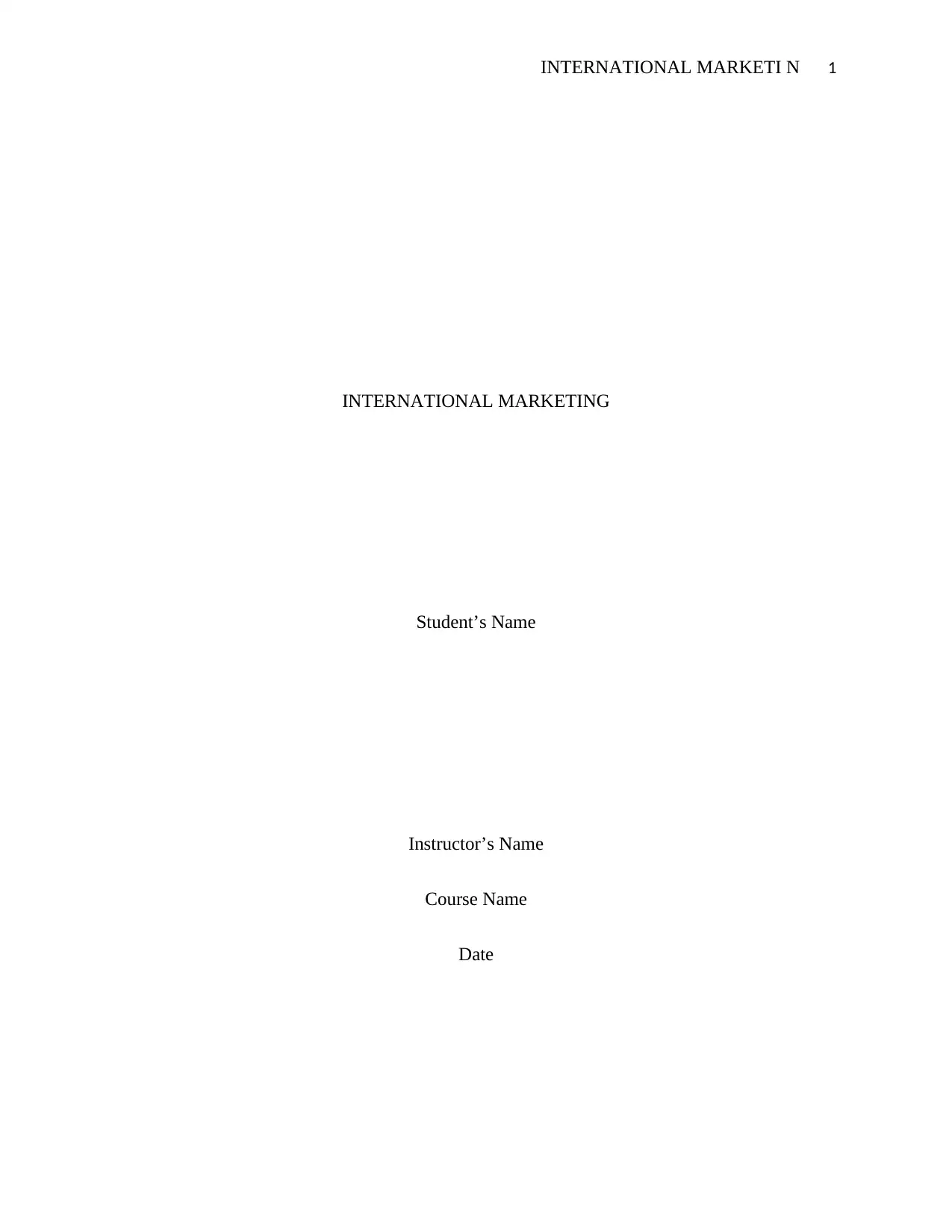
INTERNATIONAL MARKETI N 1
INTERNATIONAL MARKETING
Student’s Name
Instructor’s Name
Course Name
Date
INTERNATIONAL MARKETING
Student’s Name
Instructor’s Name
Course Name
Date
Paraphrase This Document
Need a fresh take? Get an instant paraphrase of this document with our AI Paraphraser
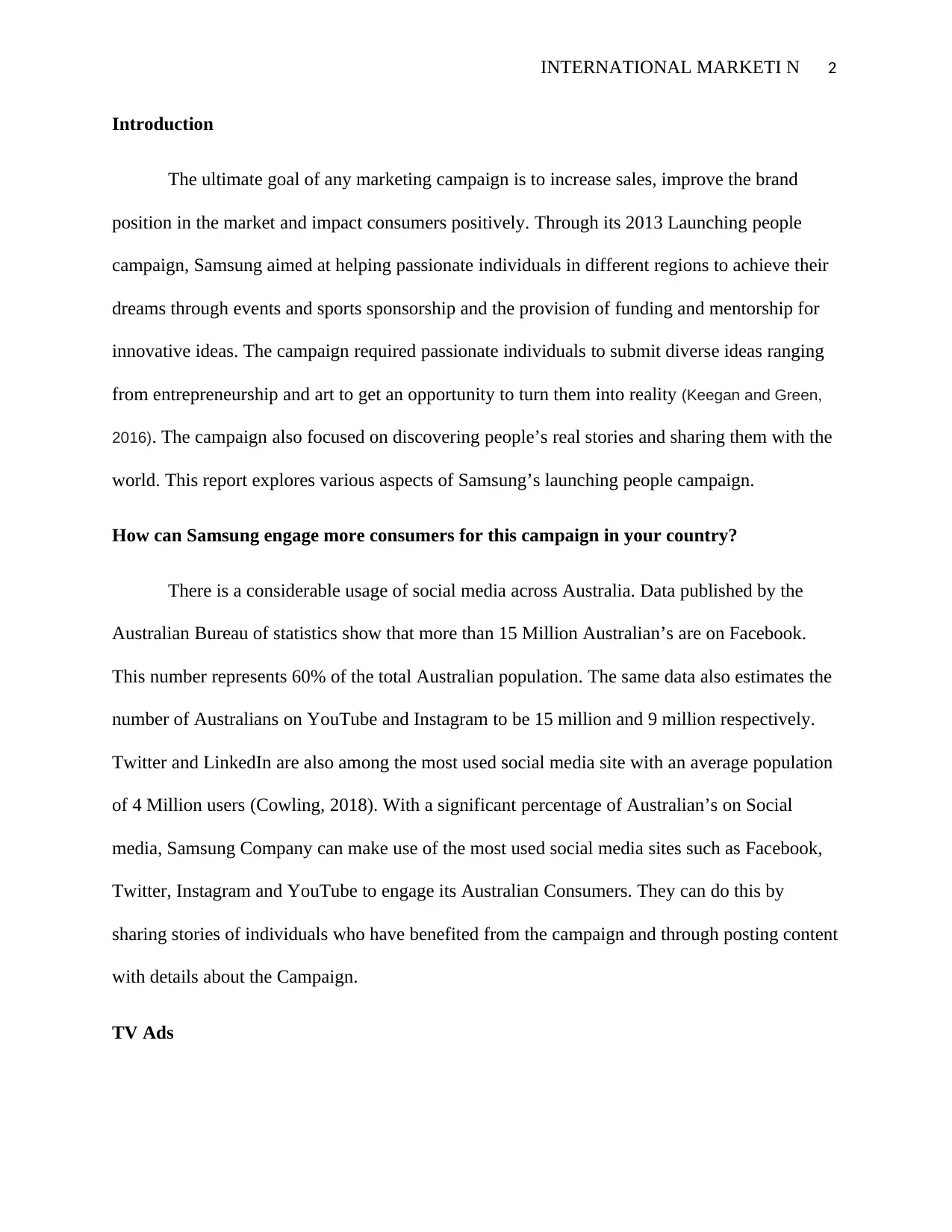
INTERNATIONAL MARKETI N 2
Introduction
The ultimate goal of any marketing campaign is to increase sales, improve the brand
position in the market and impact consumers positively. Through its 2013 Launching people
campaign, Samsung aimed at helping passionate individuals in different regions to achieve their
dreams through events and sports sponsorship and the provision of funding and mentorship for
innovative ideas. The campaign required passionate individuals to submit diverse ideas ranging
from entrepreneurship and art to get an opportunity to turn them into reality (Keegan and Green,
2016). The campaign also focused on discovering people’s real stories and sharing them with the
world. This report explores various aspects of Samsung’s launching people campaign.
How can Samsung engage more consumers for this campaign in your country?
There is a considerable usage of social media across Australia. Data published by the
Australian Bureau of statistics show that more than 15 Million Australian’s are on Facebook.
This number represents 60% of the total Australian population. The same data also estimates the
number of Australians on YouTube and Instagram to be 15 million and 9 million respectively.
Twitter and LinkedIn are also among the most used social media site with an average population
of 4 Million users (Cowling, 2018). With a significant percentage of Australian’s on Social
media, Samsung Company can make use of the most used social media sites such as Facebook,
Twitter, Instagram and YouTube to engage its Australian Consumers. They can do this by
sharing stories of individuals who have benefited from the campaign and through posting content
with details about the Campaign.
TV Ads
Introduction
The ultimate goal of any marketing campaign is to increase sales, improve the brand
position in the market and impact consumers positively. Through its 2013 Launching people
campaign, Samsung aimed at helping passionate individuals in different regions to achieve their
dreams through events and sports sponsorship and the provision of funding and mentorship for
innovative ideas. The campaign required passionate individuals to submit diverse ideas ranging
from entrepreneurship and art to get an opportunity to turn them into reality (Keegan and Green,
2016). The campaign also focused on discovering people’s real stories and sharing them with the
world. This report explores various aspects of Samsung’s launching people campaign.
How can Samsung engage more consumers for this campaign in your country?
There is a considerable usage of social media across Australia. Data published by the
Australian Bureau of statistics show that more than 15 Million Australian’s are on Facebook.
This number represents 60% of the total Australian population. The same data also estimates the
number of Australians on YouTube and Instagram to be 15 million and 9 million respectively.
Twitter and LinkedIn are also among the most used social media site with an average population
of 4 Million users (Cowling, 2018). With a significant percentage of Australian’s on Social
media, Samsung Company can make use of the most used social media sites such as Facebook,
Twitter, Instagram and YouTube to engage its Australian Consumers. They can do this by
sharing stories of individuals who have benefited from the campaign and through posting content
with details about the Campaign.
TV Ads
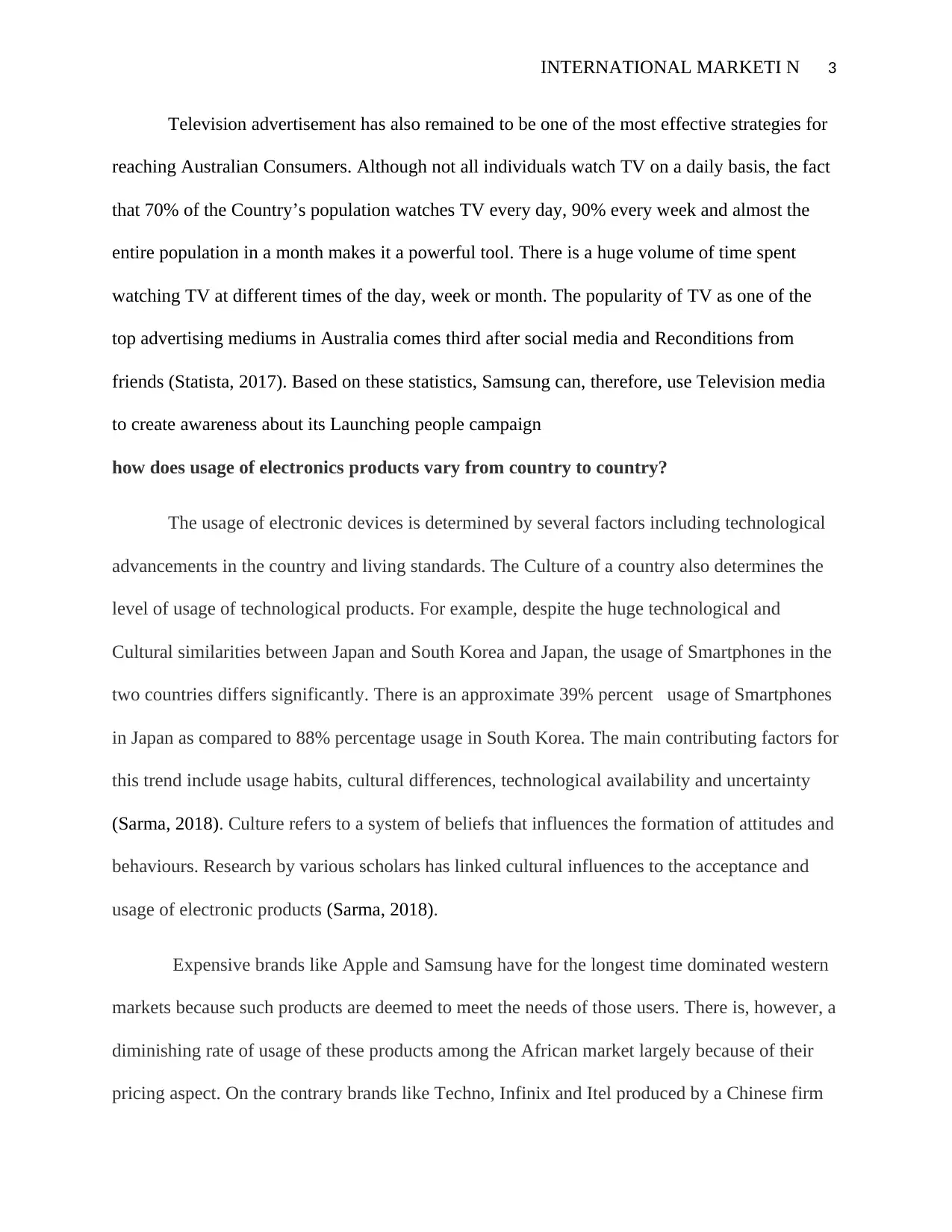
INTERNATIONAL MARKETI N 3
Television advertisement has also remained to be one of the most effective strategies for
reaching Australian Consumers. Although not all individuals watch TV on a daily basis, the fact
that 70% of the Country’s population watches TV every day, 90% every week and almost the
entire population in a month makes it a powerful tool. There is a huge volume of time spent
watching TV at different times of the day, week or month. The popularity of TV as one of the
top advertising mediums in Australia comes third after social media and Reconditions from
friends (Statista, 2017). Based on these statistics, Samsung can, therefore, use Television media
to create awareness about its Launching people campaign
how does usage of electronics products vary from country to country?
The usage of electronic devices is determined by several factors including technological
advancements in the country and living standards. The Culture of a country also determines the
level of usage of technological products. For example, despite the huge technological and
Cultural similarities between Japan and South Korea and Japan, the usage of Smartphones in the
two countries differs significantly. There is an approximate 39% percent usage of Smartphones
in Japan as compared to 88% percentage usage in South Korea. The main contributing factors for
this trend include usage habits, cultural differences, technological availability and uncertainty
(Sarma, 2018). Culture refers to a system of beliefs that influences the formation of attitudes and
behaviours. Research by various scholars has linked cultural influences to the acceptance and
usage of electronic products (Sarma, 2018).
Expensive brands like Apple and Samsung have for the longest time dominated western
markets because such products are deemed to meet the needs of those users. There is, however, a
diminishing rate of usage of these products among the African market largely because of their
pricing aspect. On the contrary brands like Techno, Infinix and Itel produced by a Chinese firm
Television advertisement has also remained to be one of the most effective strategies for
reaching Australian Consumers. Although not all individuals watch TV on a daily basis, the fact
that 70% of the Country’s population watches TV every day, 90% every week and almost the
entire population in a month makes it a powerful tool. There is a huge volume of time spent
watching TV at different times of the day, week or month. The popularity of TV as one of the
top advertising mediums in Australia comes third after social media and Reconditions from
friends (Statista, 2017). Based on these statistics, Samsung can, therefore, use Television media
to create awareness about its Launching people campaign
how does usage of electronics products vary from country to country?
The usage of electronic devices is determined by several factors including technological
advancements in the country and living standards. The Culture of a country also determines the
level of usage of technological products. For example, despite the huge technological and
Cultural similarities between Japan and South Korea and Japan, the usage of Smartphones in the
two countries differs significantly. There is an approximate 39% percent usage of Smartphones
in Japan as compared to 88% percentage usage in South Korea. The main contributing factors for
this trend include usage habits, cultural differences, technological availability and uncertainty
(Sarma, 2018). Culture refers to a system of beliefs that influences the formation of attitudes and
behaviours. Research by various scholars has linked cultural influences to the acceptance and
usage of electronic products (Sarma, 2018).
Expensive brands like Apple and Samsung have for the longest time dominated western
markets because such products are deemed to meet the needs of those users. There is, however, a
diminishing rate of usage of these products among the African market largely because of their
pricing aspect. On the contrary brands like Techno, Infinix and Itel produced by a Chinese firm
⊘ This is a preview!⊘
Do you want full access?
Subscribe today to unlock all pages.

Trusted by 1+ million students worldwide
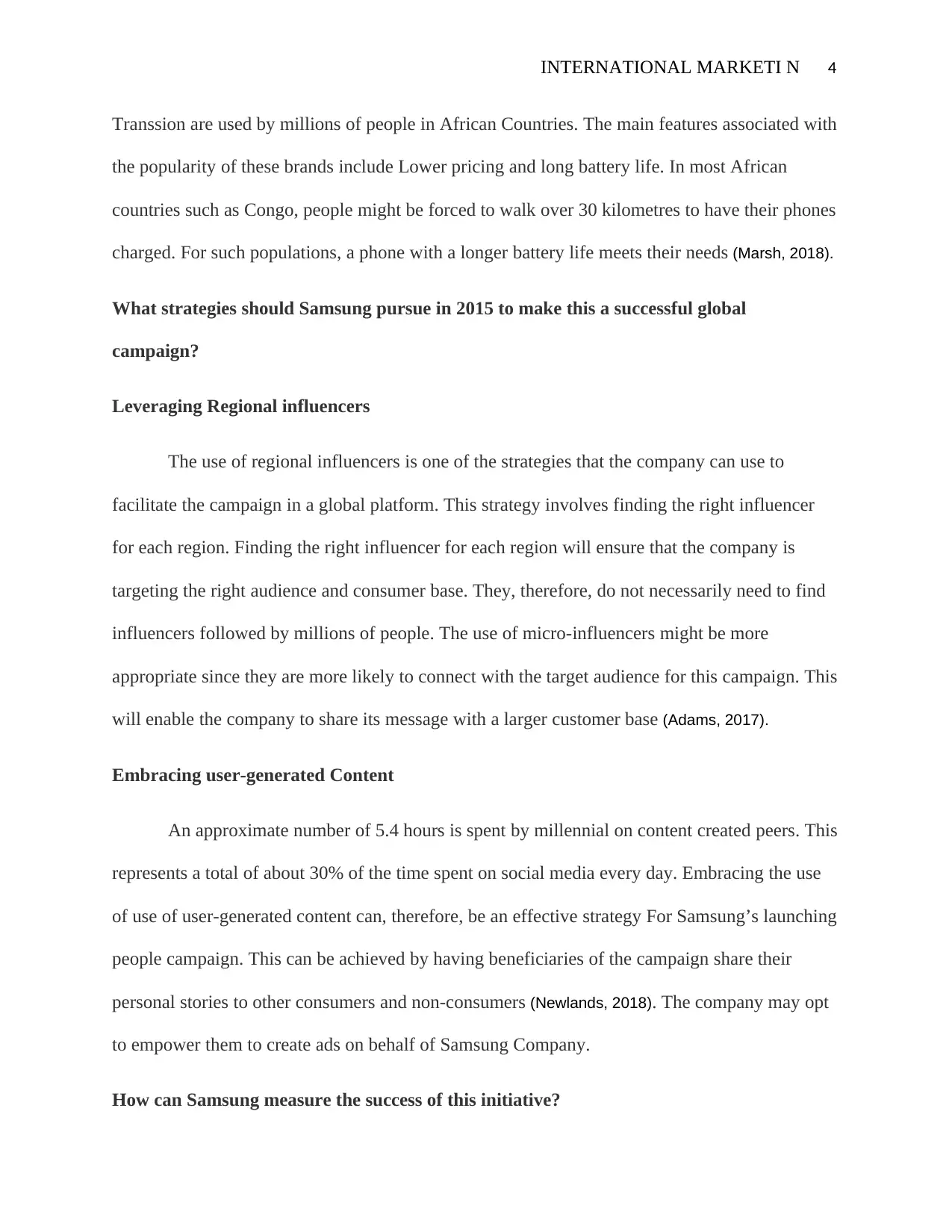
INTERNATIONAL MARKETI N 4
Transsion are used by millions of people in African Countries. The main features associated with
the popularity of these brands include Lower pricing and long battery life. In most African
countries such as Congo, people might be forced to walk over 30 kilometres to have their phones
charged. For such populations, a phone with a longer battery life meets their needs (Marsh, 2018).
What strategies should Samsung pursue in 2015 to make this a successful global
campaign?
Leveraging Regional influencers
The use of regional influencers is one of the strategies that the company can use to
facilitate the campaign in a global platform. This strategy involves finding the right influencer
for each region. Finding the right influencer for each region will ensure that the company is
targeting the right audience and consumer base. They, therefore, do not necessarily need to find
influencers followed by millions of people. The use of micro-influencers might be more
appropriate since they are more likely to connect with the target audience for this campaign. This
will enable the company to share its message with a larger customer base (Adams, 2017).
Embracing user-generated Content
An approximate number of 5.4 hours is spent by millennial on content created peers. This
represents a total of about 30% of the time spent on social media every day. Embracing the use
of use of user-generated content can, therefore, be an effective strategy For Samsung’s launching
people campaign. This can be achieved by having beneficiaries of the campaign share their
personal stories to other consumers and non-consumers (Newlands, 2018). The company may opt
to empower them to create ads on behalf of Samsung Company.
How can Samsung measure the success of this initiative?
Transsion are used by millions of people in African Countries. The main features associated with
the popularity of these brands include Lower pricing and long battery life. In most African
countries such as Congo, people might be forced to walk over 30 kilometres to have their phones
charged. For such populations, a phone with a longer battery life meets their needs (Marsh, 2018).
What strategies should Samsung pursue in 2015 to make this a successful global
campaign?
Leveraging Regional influencers
The use of regional influencers is one of the strategies that the company can use to
facilitate the campaign in a global platform. This strategy involves finding the right influencer
for each region. Finding the right influencer for each region will ensure that the company is
targeting the right audience and consumer base. They, therefore, do not necessarily need to find
influencers followed by millions of people. The use of micro-influencers might be more
appropriate since they are more likely to connect with the target audience for this campaign. This
will enable the company to share its message with a larger customer base (Adams, 2017).
Embracing user-generated Content
An approximate number of 5.4 hours is spent by millennial on content created peers. This
represents a total of about 30% of the time spent on social media every day. Embracing the use
of use of user-generated content can, therefore, be an effective strategy For Samsung’s launching
people campaign. This can be achieved by having beneficiaries of the campaign share their
personal stories to other consumers and non-consumers (Newlands, 2018). The company may opt
to empower them to create ads on behalf of Samsung Company.
How can Samsung measure the success of this initiative?
Paraphrase This Document
Need a fresh take? Get an instant paraphrase of this document with our AI Paraphraser
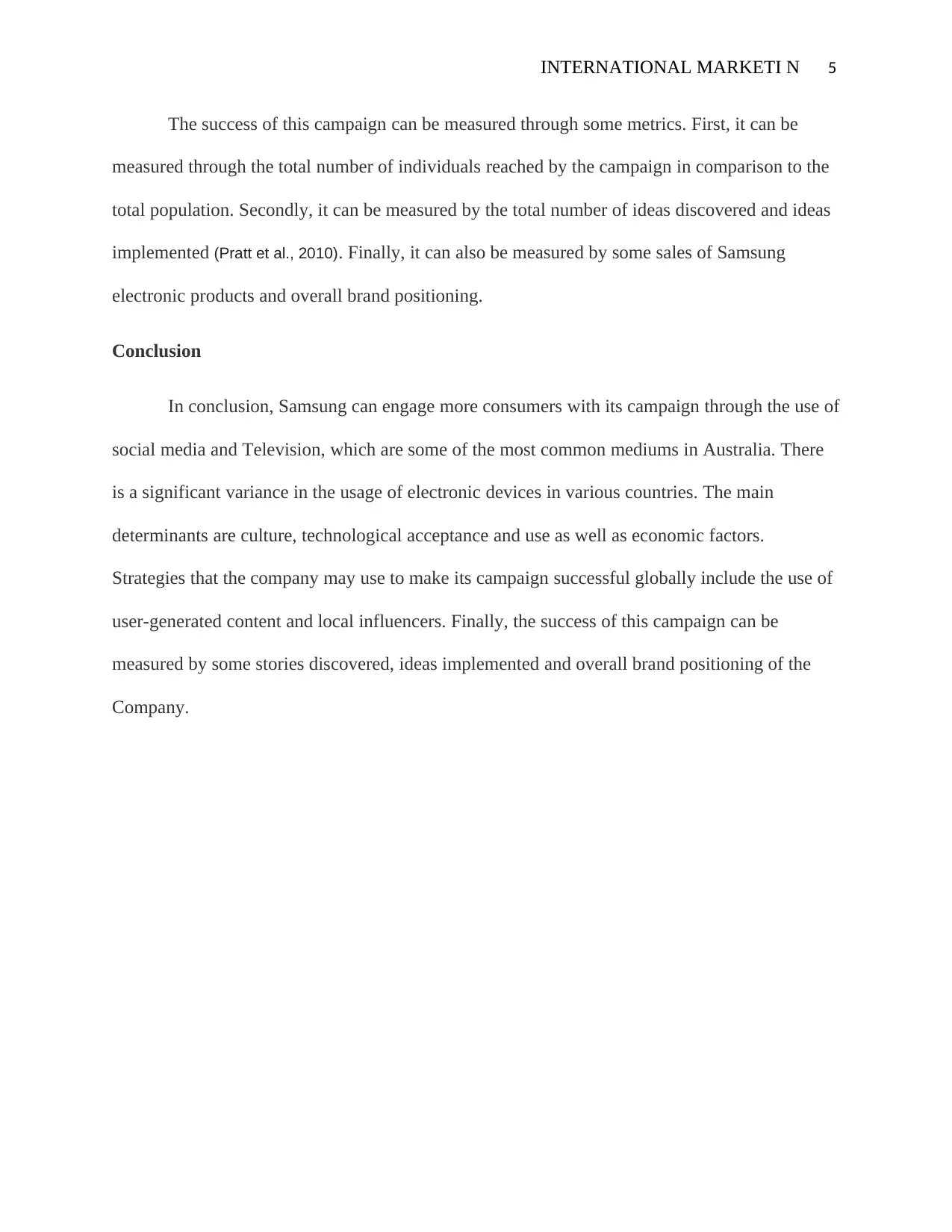
INTERNATIONAL MARKETI N 5
The success of this campaign can be measured through some metrics. First, it can be
measured through the total number of individuals reached by the campaign in comparison to the
total population. Secondly, it can be measured by the total number of ideas discovered and ideas
implemented (Pratt et al., 2010). Finally, it can also be measured by some sales of Samsung
electronic products and overall brand positioning.
Conclusion
In conclusion, Samsung can engage more consumers with its campaign through the use of
social media and Television, which are some of the most common mediums in Australia. There
is a significant variance in the usage of electronic devices in various countries. The main
determinants are culture, technological acceptance and use as well as economic factors.
Strategies that the company may use to make its campaign successful globally include the use of
user-generated content and local influencers. Finally, the success of this campaign can be
measured by some stories discovered, ideas implemented and overall brand positioning of the
Company.
The success of this campaign can be measured through some metrics. First, it can be
measured through the total number of individuals reached by the campaign in comparison to the
total population. Secondly, it can be measured by the total number of ideas discovered and ideas
implemented (Pratt et al., 2010). Finally, it can also be measured by some sales of Samsung
electronic products and overall brand positioning.
Conclusion
In conclusion, Samsung can engage more consumers with its campaign through the use of
social media and Television, which are some of the most common mediums in Australia. There
is a significant variance in the usage of electronic devices in various countries. The main
determinants are culture, technological acceptance and use as well as economic factors.
Strategies that the company may use to make its campaign successful globally include the use of
user-generated content and local influencers. Finally, the success of this campaign can be
measured by some stories discovered, ideas implemented and overall brand positioning of the
Company.
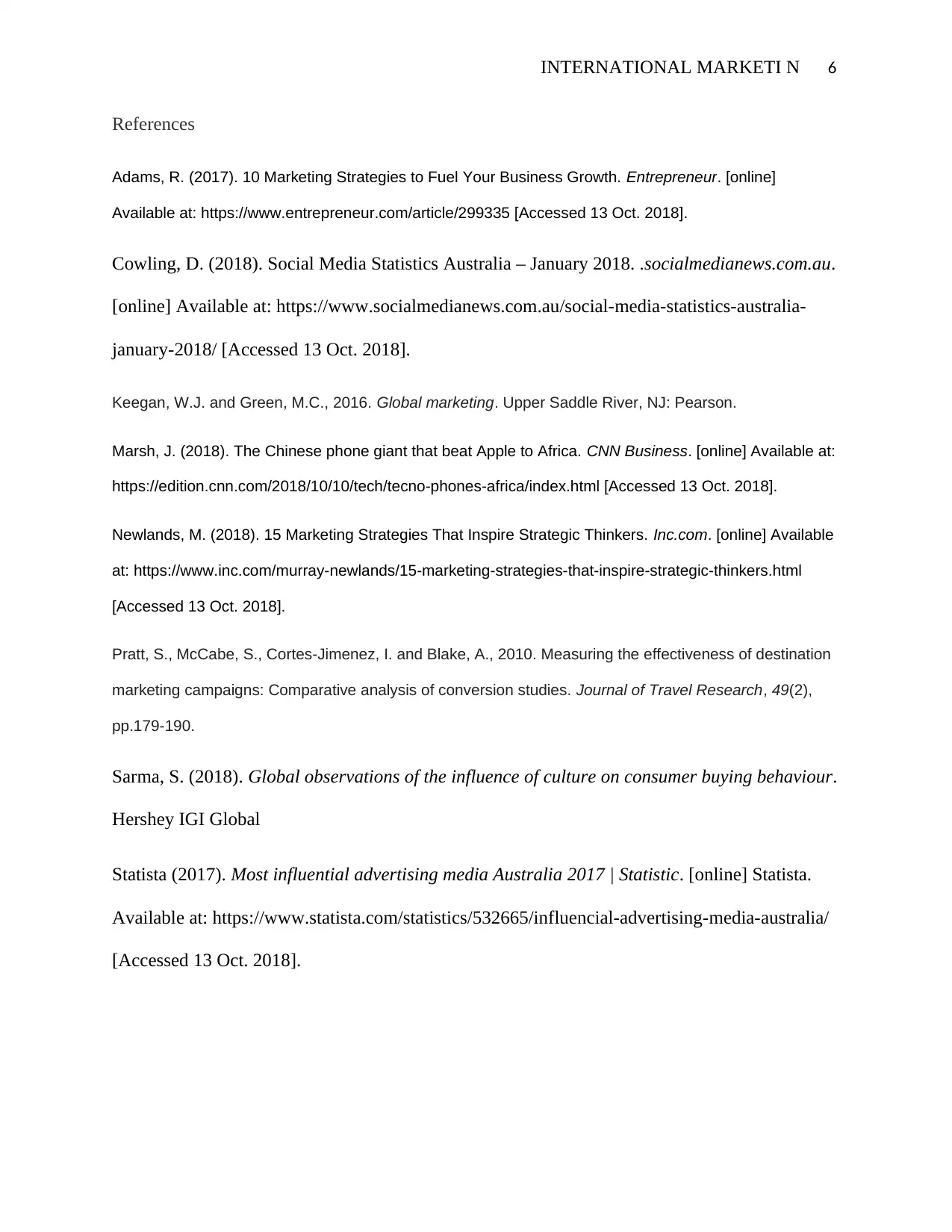
INTERNATIONAL MARKETI N 6
References
Adams, R. (2017). 10 Marketing Strategies to Fuel Your Business Growth. Entrepreneur. [online]
Available at: https://www.entrepreneur.com/article/299335 [Accessed 13 Oct. 2018].
Cowling, D. (2018). Social Media Statistics Australia – January 2018. .socialmedianews.com.au.
[online] Available at: https://www.socialmedianews.com.au/social-media-statistics-australia-
january-2018/ [Accessed 13 Oct. 2018].
Keegan, W.J. and Green, M.C., 2016. Global marketing. Upper Saddle River, NJ: Pearson.
Marsh, J. (2018). The Chinese phone giant that beat Apple to Africa. CNN Business. [online] Available at:
https://edition.cnn.com/2018/10/10/tech/tecno-phones-africa/index.html [Accessed 13 Oct. 2018].
Newlands, M. (2018). 15 Marketing Strategies That Inspire Strategic Thinkers. Inc.com. [online] Available
at: https://www.inc.com/murray-newlands/15-marketing-strategies-that-inspire-strategic-thinkers.html
[Accessed 13 Oct. 2018].
Pratt, S., McCabe, S., Cortes-Jimenez, I. and Blake, A., 2010. Measuring the effectiveness of destination
marketing campaigns: Comparative analysis of conversion studies. Journal of Travel Research, 49(2),
pp.179-190.
Sarma, S. (2018). Global observations of the influence of culture on consumer buying behaviour.
Hershey IGI Global
Statista (2017). Most influential advertising media Australia 2017 | Statistic. [online] Statista.
Available at: https://www.statista.com/statistics/532665/influencial-advertising-media-australia/
[Accessed 13 Oct. 2018].
References
Adams, R. (2017). 10 Marketing Strategies to Fuel Your Business Growth. Entrepreneur. [online]
Available at: https://www.entrepreneur.com/article/299335 [Accessed 13 Oct. 2018].
Cowling, D. (2018). Social Media Statistics Australia – January 2018. .socialmedianews.com.au.
[online] Available at: https://www.socialmedianews.com.au/social-media-statistics-australia-
january-2018/ [Accessed 13 Oct. 2018].
Keegan, W.J. and Green, M.C., 2016. Global marketing. Upper Saddle River, NJ: Pearson.
Marsh, J. (2018). The Chinese phone giant that beat Apple to Africa. CNN Business. [online] Available at:
https://edition.cnn.com/2018/10/10/tech/tecno-phones-africa/index.html [Accessed 13 Oct. 2018].
Newlands, M. (2018). 15 Marketing Strategies That Inspire Strategic Thinkers. Inc.com. [online] Available
at: https://www.inc.com/murray-newlands/15-marketing-strategies-that-inspire-strategic-thinkers.html
[Accessed 13 Oct. 2018].
Pratt, S., McCabe, S., Cortes-Jimenez, I. and Blake, A., 2010. Measuring the effectiveness of destination
marketing campaigns: Comparative analysis of conversion studies. Journal of Travel Research, 49(2),
pp.179-190.
Sarma, S. (2018). Global observations of the influence of culture on consumer buying behaviour.
Hershey IGI Global
Statista (2017). Most influential advertising media Australia 2017 | Statistic. [online] Statista.
Available at: https://www.statista.com/statistics/532665/influencial-advertising-media-australia/
[Accessed 13 Oct. 2018].
⊘ This is a preview!⊘
Do you want full access?
Subscribe today to unlock all pages.

Trusted by 1+ million students worldwide
1 out of 6
Related Documents
Your All-in-One AI-Powered Toolkit for Academic Success.
+13062052269
info@desklib.com
Available 24*7 on WhatsApp / Email
![[object Object]](/_next/static/media/star-bottom.7253800d.svg)
Unlock your academic potential
Copyright © 2020–2025 A2Z Services. All Rights Reserved. Developed and managed by ZUCOL.




